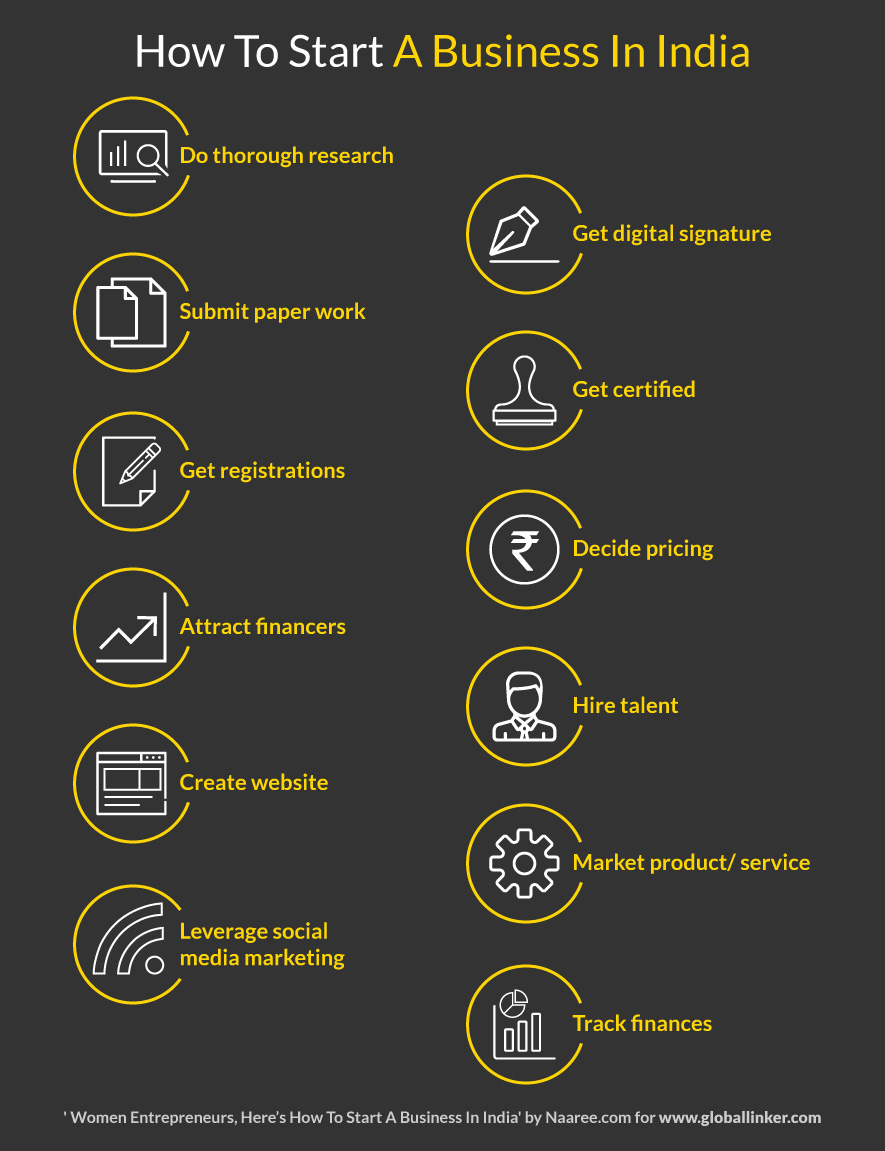Women entrepreneurs, here’s how to start a business in India

Women Entrepreneurship
470 week ago — 10 min read
India has emerged as the best place for women entrepreneurs to start a business with high level of optimism on various factors that are important to judge business growth, according to a study by PC maker, Dell.
Dell Women’s Global Entrepreneurship Study conducted among 450 women entrepreneurs across India, the US and the UK, by research firm Penn Schoen Berland, found that Indian women entrepreneurs are more confident of their business growth, as compared to counterparts in the US and the UK.
Starting a business might not be the easiest job on earth, but it is definitely not the most difficult. Now is the right time for you to get out of the cubicle or kitchen, wherever you are, and start your own business. Work hard on your own terms, and not only will you add to the country’s prosperity, but also create your own individuality.
Here are some tips to help aspiring women entrepreneurs learn how to set up a business in India.
1. Decide your business type
First things first. Decide what your business would be about. Are you manufacturing products, providing services or will you be a re-seller? Do you want to be a distributor or would you be hiring staff to create the products?
You need to understand that there are various forms of business entities in India and yours will fall under one of them. The types are:
• A Private Ltd. Co. where there are rights of shareholders are restricted regarding transfers and has to have minimum of two members with a maximum of 50.
• A Public Ltd. Co. is where shareholders have the power to transfer their shares and there is no limit to the number of members as long as there are a minimum of seven.
• An Unlimited Co. is where there is no limit to the liabilities of any of its members.
• A Sole Proprietorship is where the business is owned by an individual.
• One Person Company is a new concept in India which has been introduced by the companies act 2013. In the old Companies act 1956 a minimum of two directors and shareholders were required to form a private limited company. However, in case of a One person company, only one person is required, who can be a shareholder as well as the Director. Hence the name, One Person Company.
• A Partnership is where the business is owned by two of more people where they have agreed to equal share of the profits.
• Cooperatives are voluntary organisations under Cooperative Societies Act 1912.
• A Subsidiary Company is where private, public, unlimited and sole proprietorship have the permission to have foreign direct investment of up to 100%.
• Joint Hindu Family business is a business type governed by Hindu law and in this type only members of the same family can manage this business.
• A Limited Liability Partnership (LLP) is where while all members have limited liability, only one has unlimited liability in the business.
2. Do thorough research
Do enough research – of the market, the product, the target buyers and other factors which will affect your business in the long and short term. Everyone out there has a business idea and most of them are really good. However, the path from ideation to implementation is not a short one and this is what decides whether the business will be a success or not.
Just having an idea and arranging for funds isn’t enough to get the ball rolling. If you are getting investments into your project, it is your prerogative to do all the research and only once everything has been cross-checked, to jump in.
3. Work with the facts
Don’t move ahead based on assumptions. You need facts. Assuming that the market will get better in a few months is not a good enough reason for you to start a business selling a product which isn’t selling well at this point of time. What if things don’t revive after a few months? Your dreams and you, both will not succeed.
4. Get your digital signature
Once you’ve decided what you are doing your business in, you need a digital signature certificate from a Ministry of Corporate Affairs (MCA) authorized agency. This takes up to five days but is important. This can be obtained from any one of the six vendors in the country.
The documents required include:
• Class-II form
• Self-attested copy of Driver’s License/Ration Card/Voter ID/Aadhar Card or Latest Utility Bills
• Self-attested PAN card for Indian nationals
• Self-attested copy of Passport in case of foreign nationals
5. Do your paper work
With the above step done, you will need to prepare the INC-29 form which is done by a Company Secretary. This procedure is a bit complicated and requires a lot of documents. So, while re-submission is allowed, it is not wise to waste time. Hence, do all checks and submit accordingly.
You will also require the Director Information Number (DIN) for which one, two or three directors of the company can apply. The DIN is what the MCA identifies the company directors.
The documents required include:
• Scanned passport sized photographs
• Scanned copy of PAN (if Indian nationals, passport with foreign)
• Self-attested Voter ID/Latest utility bill/driver’s license.
If you are a foreign national, you will need to get the scanned copies notarized from the Indian embassy.
Before registering the name of your company, you will need to confirm from mca.gov.in that the name has not been taken and neither is there any registered trademark to the same name.
6. Submit the paper work
Once the INC-29 is ready, it needs to be submitted/filed along with the fee, stamp duty and authorized capital fee. These are dependent on your location.
7. Get certified
Moving ahead, you will need to get the Incorporation Certificate from the government which is a big step ahead.
8. Get the required registrations
When you are registering your business, you will also need to get your bank account registration, TAN number, registration of various acts and all fermented and suggested ways. You will need to register your PAN as well as TAN numbers.
There are a bunch of other registrations that need to be done, depending on the type of company you have formed for your business – sole proprietorship, partnership, limited liability partnership, private limited company, or public limited company.
9. Decide the pricing
Once all the above steps are done and main paper work is behind you, you decide the pricing of your products or services.
10. Attract financers
If you require financers or angel investors, this is a good time to go ahead and approach them with a solid business plan. However, do remember that if they are going to pump in their money into your project, they will automatically have an opinion, which might not go well with you. If they are the money-people, then it is advised that you stay in their good books.
11. Hire talent
If you are planning to manufacture, getting raw materials, staff and renting, and buying property needs to be completed. Once your staff has been hired, they need to be trained accordingly. Calculate the manpower strength you will need.
12. Create website
If your business is online, then you need to create an online store and you need a website. This not only makes your business looks formal and serious, but is the best way to advertise it. For this, you will need a domain and hosting service and once you’ve got them, you can either create a website yourself or you can outsource is to a freelance designer.
13. Market your product/ service
Advertising is important. If you are a manufacturer, you will need to personally meet your prospective clients and get orders in the beginning. If you are a seller or a re-seller, then you need to advertise your brand as well as your product.
While word of mouth is still the best way to spread news, along with traditional advertising, you now also have access to the vast world of digital marketing. The country is going digital; it’s time your business does too. Your reach will increase and so will your sales.
14. Leverage digital marketing
Create a website and get it optimized for search engines using SEO. Start a blog and post regular updates to it. Join buyer and seller groups on Facebook, pin your products with links back to your website on Pinterest, send out updates about new products on Twitter and Linkedin, and promote your business on your own Facebook business page. Hire a social media agency to do this if you don’t have the time to do it yourself.
15. Practice cost cutting
Make sure you keep a track of expenditures, big as well as small, right from day one. Not only does this ensure no money is getting wasted, it also tells you where you can cut some cost. There will come times in your business, whether in the beginning or once it is on its way to growth, when you’ll need to cut costs. Keeping track of expenditures ensures that too much is not spent right from the very beginning.
16. Track your finances
Having said that, keep a financial buffer. A working spouse is always great if you are dropping your 9-to-5 job and starting a business. If not, it will be difficult. In families where both the partners are working, while the income is more, so are expenditures.
A financial buffer is important before you start your business. Calculate how long it will take for you to start bringing home a decent amount of money to the table. Until then, your family and you will be surviving on the buffer amount.
You are ready to start your business. All the best!
Article & image source: http://www.naaree.com/how-to-start-a-business-in-india/
Disclaimer: The views and opinions expressed in this article are those of the author and do not necessarily reflect the views, official policy or position of GlobalLinker.

Posted by
Priya Florence ShahI'm the Founder and CEO of BlogBrandz Digital LLP, an award-winning online publisher, bestselling author, and online branding consultant. Visit BlogBrandz.com/tips for online...
View Priya Florence 's profile
Other articles written by Priya Florence Shah
The rise of mompreneurs in India
459 week ago
5 reasons why women make better leaders
469 week ago
Most read this week
Trending
Get Efficient at Taking Decisions
Lãnh đạo & Quản lý 23 week ago
The Art & Science of People Pleasing in Retail
Bán lẻ 26 week ago
Khởi nghiệp 26 week ago













Comments
Share this content
Please login or Register to join the discussion